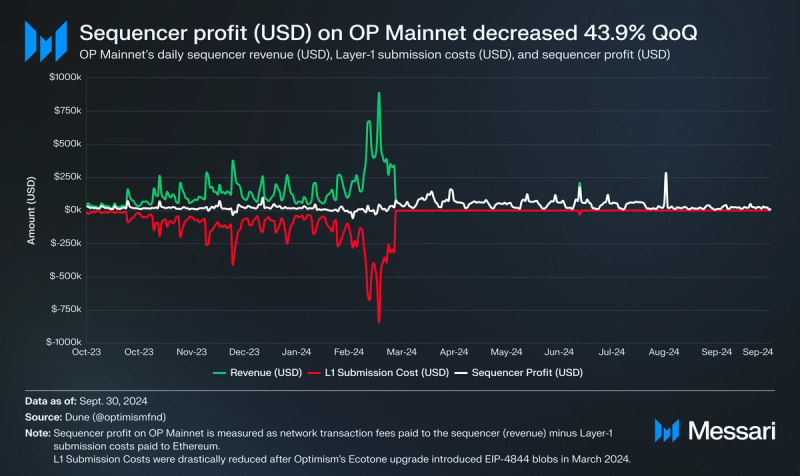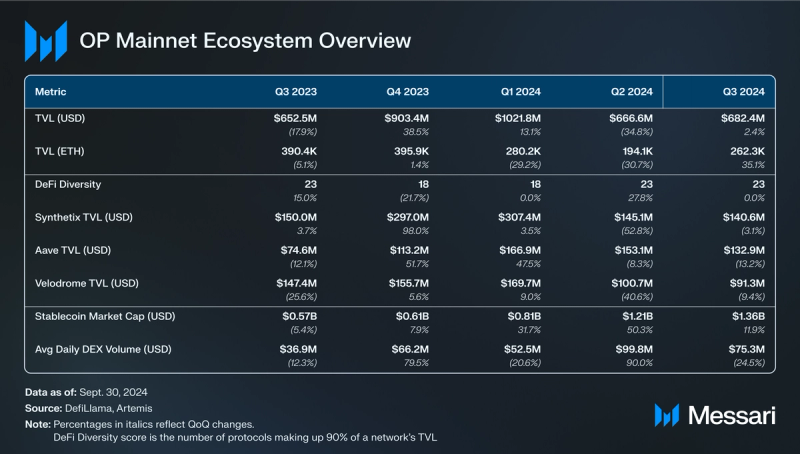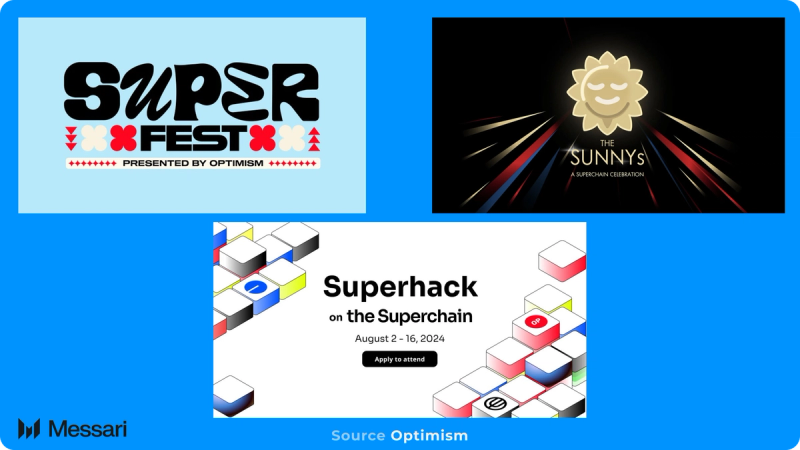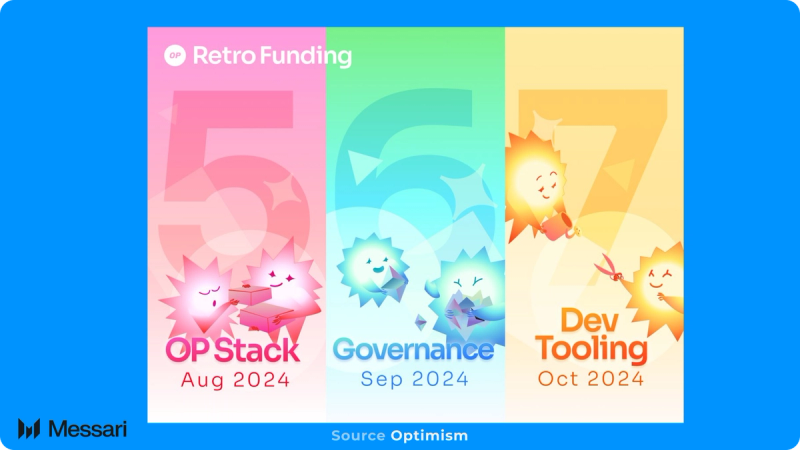Key Insights
- Optimism’s Fjord and Granite upgrades were approved and went live on OP Mainnet, optimizing various gas and data availability functions and re-enabling permissionless fault proofs on the network.
- TVL (USD) increased 2.4% QoQ to $682.4 million, while TVL (ETH) increased 35.1% to 262,300. Average daily DEX volume (USD) on OP Mainnet fell 24.5% to $75.3 million.
- Sequencer profit (USD) on OP Mainnet fell 43.9% QoQ to $2.9 million, though the sequencer’s profit margin increased 168.9% QoQ to 20,994%.
- OP’s price decreased 2.9% QoQ to $1.75, though its market cap rank rose from 45th to 43rd, indicating slight outperformance of the broader market.
- OP Mainnet’s stablecoin market cap increased 11.9% QoQ to $1.36 billion. USDT led growth as its market cap rose 22.6% QoQ to $1.18 billion, while USDC’s market cap fell 41% to $95.5 million.
Primer
Optimism (OP) is a Layer-2 network that aims to increase Ethereum’s transaction throughput while decreasing the cost of transacting. This is achieved through an optimistic rollup design. Transactions are executed on OP Mainnet, Optimism’s original network, while relying on Ethereum for settlement, consensus, and data availability.
After years of research on Ethereum scalability by founders Benjamin Jones, Karl Floersch, Jing Wang, Mark Tyneway, and Kevin Ho, Optimism launched on public mainnet in December 2021. The years that followed saw Optimism Foundation and OP Labs constantly experiment, develop, and iterate a long-term vision. This included introducing the Optimism Collective, launching the OP token via an airdrop, introducing the OP Stack, launching the Bedrock upgrade, and more.
Optimism’s long-term strategy stems from its vision for a “Superchain.” The OP Stack, Optimism’s modular, open-source, forkable technology stack, allows for the creation of Layer-2 and Layer-3 networks (”OP Chains”). The Superchain is a network of OP Chains built with the OP Stack, including OP Mainnet. The ultimate goal of the Superchain is to bring seamless interoperability between OP Chains that share security, bridging, governance, upgrades, and a communication layer.
Website / X (Twitter) / Discord
Key Metrics
Financial Analysis


OP’s price decreased 2.9% QoQ to $1.75 as its fully diluted market cap (FDV) fell to $7.51 billion in Q3 2024. OP’s circulating supply increased 11.9% QoQ to 1.26 billion, leading to its circulating market cap growing 8.6% QoQ to $2.19 billion. The token slightly outperformed the broader market in Q3’24. Its circulating market cap rank trended up from 45th to 43rd as OP finished in a strong uptrend, increasing 23.4% in September. This made it the third largest Layer-2 token by market cap, behind Polygon (POL) and Immutable X (IMX), and just ahead of Arbitrum (ARB) and Mantle (MNT).
OP is an ERC-20 equivalent token on OP Mainnet that began circulating on May 31, 2022, with a total token supply of 4.29 billion. OP serves functions related to governance and incentives:
- Governance: Optimism is governed by the Optimism Collective, a bicameral system comprising the Token House and Citizens’ House. The Token House consists of all OP tokenholders and governs network changes through onchain proposal voting via Agora. OP grants the ability for a tokenholder to delegate OP to themselves or to another delegate.
- Incentives: Optimism stakeholders are incentivized to grow the Optimism ecosystem through the following programs:
- Ecosystem Fund: 1.07 billion OP (25% of the total supply) were allocated to an Ecosystem Fund designed to stimulate the development of the Optimism ecosystem through four subcategories (Governance Fund, Partner Fund, Seed Fund, and Unallocated Reserves).
- Retroactive Public Goods Funding (RetroPGF): 859 million OP (20% of the total supply) was allocated to RetroPGF, where funds are distributed by the Citizens’ House to community members that have previously impacted Optimism, based on each round’s scope.
- Airdrops: 816 million OP (19% of the total supply) were allocated for Optimism user airdrops. Eligibility criteria for each round of airdrops vary and are determined by Optimism Foundation.
Sequencer

Optimism Foundation controls the lone sequencer that executes pending transactions stored in a private mempool on OP Mainnet. Blocks of executed transactions on OP Mainnet are created every two seconds and periodically batch-submitted as EIP-4844 blobs to Ethereum by the sequencer. Optimism’s Ecotone upgrade was approved and went live in March 2024, introducing EIP-4844 blobs for data availability after Ethereum’s Dencun upgrade. This has resulted in more than a 90% reduction in transaction fees on OP Mainnet as Layer-1 submission cost savings are passed down to users.
In Q3’24, sequencer revenue (USD) from network transaction fees fell 44.3% to $2.9 million. With a cumulative Layer-1 submission cost (USD) of $14,000, Optimism Foundation’s sequencer profit (USD) was $2.9 million in Q3, down 43.9% QoQ. This resulted in a profit margin of 20,994%, a 168.9% QoQ increase. Notably, sequencer profits are not retained by Optimism Foundation. Rather, they are distributed to the Optimism Collective’s treasury to fund RetroPGF.
Network Analysis


Optimism averaged 174 weekly active core developers and 285 weekly active ecosystem developers in Q3 2024, which were down 24% and 26.7% QoQ, respectively. Average daily active addresses (DAAs) on OP Mainnet decreased 41.1% QoQ to 71,700, while daily transactions fell 0.7% to 597,000.
The ratio of transactions to active addresses (txs/DAAs) increased 68.5% QoQ to 8.33, suggesting an increase in “power users” of OP Mainnet; conversely, a decreasing ratio suggests activity is being distributed more evenly across users.

Average daily new addresses fell 48.5% QoQ to 14,100, while average daily returning addresses fell by a lesser 38.9% to 57,600. These changes indicate that activity was more concentrated among returning addresses rather than new ones in Q3’24. This is in contrast to Q1’24, which saw growth in new addresses outpace growth in returning addresses, while Q2’24 saw growth equally balanced among both metrics.
Network Developments

Optimism had several significant network upgrades and technical developments in Q3 2024:
- In July 2024, Optimism’s Fjord upgrade was approved and went live on OP Mainnet, introducing changes meant to further optimize various gas and data availability functions.
- In August 2024, OP Labs announced the development of a native Interoperability standard, aiming to increase interoperability across OP Chains resulting in increased fungibility, composability, speed, and ultimately, a better user experience (UX).
- In September 2024, Optimism’s Granite upgrade was approved and went live on OP Mainnet. This upgrade re-enabled permissionless fault proofs on the network.
- OP Mainnet’s permissionless fault proof system, the Cannon Fault Proof Virtual Machine (FPVM), was approved and went live on OP Mainnet in June 2024. Thus, the network reached Stage 1 Decentralization, as anyone could now challenge the state of the network through incentivized Fault Dispute Games (FDGs). However, in August 2024, the fault proof system on OP Mainnet was reverted to a permissioned version.
- FDGs allow for anyone to put up a bond denominated in ETH to either (i) submit Permissionless Output Proposals (PoPs) that make a claim about the state of the network, or (ii) dispute the validity of claims made about the state of the network. Successful PoPs can be used to circumvent the sequencer and withdraw assets from Layer-2 (OP Mainnet) to Layer-1 (Ethereum).
Ecosystem Analysis


Infrastructure was the leading category among transactional activity across active addresses on OP Mainnet in Q3 2024. Transactions in this category were up 21.7% QoQ, making up 39.9% of transactional activity on OP Mainnet through applications such as World, Chainlink, and Gnosis. Following that were wallet-to-wallet transfers and DeFi, which made up 18.9% and 15.6% of transactional activity on OP Mainnet in Q3’24, respectively.
DeFi

OP Mainnet’s TVL (USD) increased 2.4% QoQ to $682.4 million. TVL increased despite ETH’s price decreasing by 24.2% QoQ. Thus, TVL (ETH) rose 35.1% QoQ to 262,300. OP Mainnet’s DeFi Diversity score (i.e., the number of protocols making up 90% of a network’s TVL) stayed constant at 23 in Q3 2024. OP Mainnet saw an average daily DEX volume of $75.3 million in Q3, a 24.5% QoQ decrease. Velodrome and Uniswap maintained their historical dominance over OP Mainnet’s trading volume in Q3’24.
Aave was the leading protocol by TVL, though saw an 8.2% QoQ decrease to $140.6 million. Synthetix ended the quarter with $132.9 million in TVL while Velodrome ended with $91.3 million. Both Synthetix and Velodrome were down a similar percentage as Aave, 8.4% and 9.4% QoQ, respectively. dHEDGE was a notable outperformer in Q3’24 as its TVL increased 109.1% to $41.7 million. The “Other” category, which aggregates protocols outside of the top nine, was up 19.5% QoQ to $244.6 million, suggesting the distribution of TVL on OP Mainnet is continuing to diversify.

OP Mainnet’s stablecoin market cap continued its uptrend for the fourth straight quarter in Q3 2024, ending up 11.9% to $1.36 billion. USDT continued to outperform as its market cap increased 22.6% QoQ to $1.18 billion, commanding 87% of stablecoins on OP Mainnet. In contrast, USDC’s market cap fell 41% to $95.5 million, ending the quarter with a 7% share of stablecoins on OP Mainnet.
Developers & Community

Optimism has a strong focus on developers and an ethos of shared contributions to the Optimism Collective and the OP Stack. In Q3 2024, Optimism put on the following community programs:
- In July 2024, Optimism announced the SuperFest, a DeFi-focused program that distributed 1.5 million OP to users interacting with DeFi protocols across four OP Chains, including OP Mainnet. The program concluded in September 2024.
- In July 2024, Optimism announced the Superhack 2024, a hackathon conducted over two weeks in August that focused on the Superchain, inclusive of OP Mainnet.
- In August 2024, Optimism announced the Sunnys, an awards ceremony designed to honor the achievements of Superchain builders, inclusive of OP Mainnet developers. The Sunnys distributed 540,000 OP in prizes to winners.
Governance
Optimism is governed by the Optimism Collective, a bicameral system comprising the Token House and Citizens’ House, along with stewardship provided by Optimism Foundation.
Token House
The Token House consists of all OP tokenholders and governs network changes through onchain voting via Agora. OP grants the ability for a tokenholder to delegate OP to themselves or to another delegate. Delegates can vote on proposals related to Governance Fund budgets, network upgrades, inflation adjustments, treasury appropriations, grant clawbacks, council elections, council dissolutions, etc.
Token House proposals fall under Non-grant Proposals, or Governance Fund Grant Proposals that distribute OP tokens from the Governance Fund on a seasonal schedule. A new season occurs each quarter and consists of several voting cycles. In Q3 2024, Season 6 was ongoing, first beginning in June 2024 and scheduled to conclude in December 2024. The voting cycles that occurred in Q3 include voting cycles #24, #25, #26, #27, and #28.
Citizens’ House

The Citizens’ House consists of “Citizens,” core Optimism community members (not required to hold OP tokens) that are appointed largely to govern over RetroPGF distributions. These Citizens hold voting badges and operate under a one-person, one-vote system. RetroPGF occurs in rounds, and Citizens vote on which projects should receive funding. Before each round, a scope of funding is determined. The initial rounds of RetroPGF have scope and funding amounts determined by Optimism Foundation, though the foundation plans to hand off this aspect to the Citizen House in the future.
- In July 2024, Optimism Foundation announced RetroPGF 5, and applications opened in August 2024. In total, 8 million OP tokens were distributed to contributors to Ethereum, OP Stack R&D, and OP Stack tooling. In total, 79 projects were rewarded.
- In September 2024, Optimism Foundation announced RetroPGF 6, where between 1.1 million and 3.5 million OP will be distributed after voting concludes on Nov. 19, 2024. Applications for contributors of infrastructure, tooling, analytics, and leadership related to Optimism governance opened on Oct. 1, 2024.
- RetroPGF 7 will focus on rewarding Optimism builders of developer tooling and is slated for Q1 2025.
Closing Summary
OP Mainnet experienced mixed results across key metrics in Q3 2024. Sequencer profit (USD) on OP Mainnet fell 43.9% QoQ to $2.9 million, though the sequencer’s profit margin increased 168.9% QoQ to 20,994%. Daily active addresses fell 41.1% to 71,700 while daily transactions fell 0.7% to 597,000. The price of OP decreased 2.9% QoQ to $1.75, though its market cap rank rose from 45th to 43rd, indicating slight outperformance of the broader market.
TVL (USD) on OP Mainnet increased 2.4% QoQ to $682.4 million, while TVL (ETH) increased 35.1% to 262,300. Uniswap and Velodrome maintained their dominance over trading volume (USD), though average daily DEX volume on OP Mainnet fell 24.5% to $75.3 million. Stablecoin market cap increased 11.9% QoQ to $1.36 billion. USDT led the growth as its market cap increased 22.6% QoQ to $1.18 billion. Meanwhile, USDC’s market cap fell 41% QoQ to $95.5 million.
OP Labs and Optimism Foundation continued to support OP Mainnet through various efforts in Q3. OP Labs contributed to Optimism’s Fjord and Granite upgrades that provided various optimizations and re-enabled permissionless fault proofs. The Optimism Foundation generated excitement in the community via the SuperFest, Superhack 2024, and the Sunnys. Furthermore, RetroPGF 5 concluded and distributed 8 million OP tokens to 79 projects while RetroPGF6 kicked off.





















